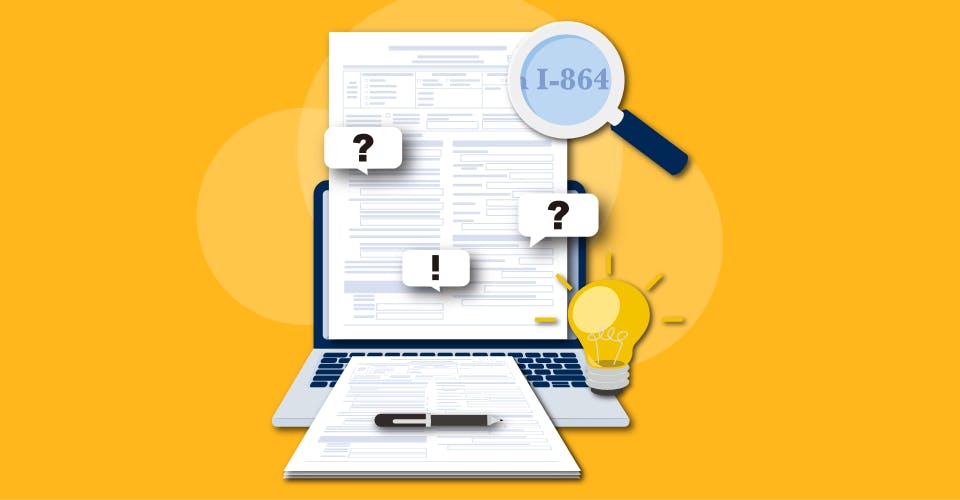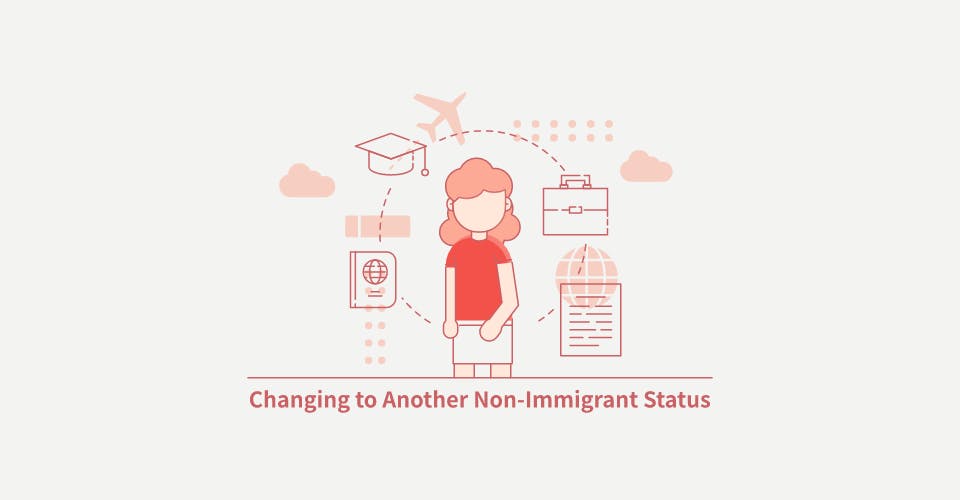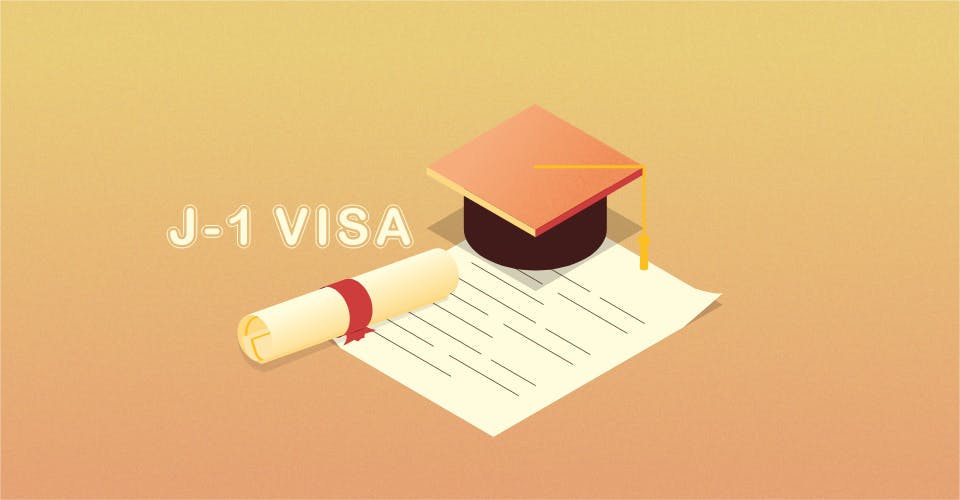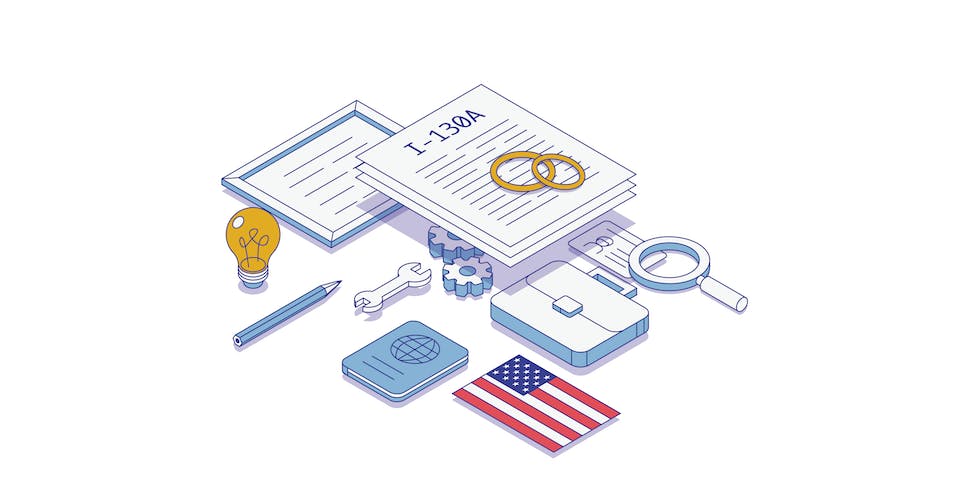The I-864 form is essentially a document verifying a financial sponsorship from a U.S. citizen on behalf of an immigrant. It is used in the case of family-based or marriage-based immigration. The form works for both processing domestically with the USCIS, and in the case of immigrants abroad who need to go through consular processing. The overall purpose of this form is to prove to the U.S. government that a financial sponsor is contractually obligated to support their immigrant counterpart when they come to the U.S., or to adjust their status from within, and do not become a public charge in the process. The form can be downloaded from the USCIS website and is also available here.
In many cases, the petitioning U.S. citizen will be the same sponsor who is filling out the I-864. In other words, if you have filed an I-130 petition (the petition that proves a family/blood relationship, or a marriage), you are also the same individual who will be filing the I-864, which is proving to the U.S. government that you have the income requirements to sponsor a foreign national.
The only circumstances in which a U.S. citizen does not also file the I-864 is if they have passed away in the time after they have filed an I-130, but before they were able to file an I-864, or if they cannot meet the financial requirements to sponsor somebody and don’t have a joint sponsor to do so.
In this brief guide, we’ll break down some of the procedural elements of filing the I-864:
Who will be filing
As mentioned, the U.S. citizen who is a close family relative and already petitioning individual will need to fill out the I-864. In the case of death by the original I-130 petitioner, a substitute sponsor may sign this form. In the first section of the form, there will be options for the signatory to fill out, marking who exactly they are in the process (original sponsor, substitute sponsor, or joint sponsor).
A joint sponsor is defined as someone who also decides to sign onto supporting the immigrating applicant, if the substitute sponsor is unable to fulfill such financial requirements. In general, both conditions need to meet for a successful adjustment of status. Usually, a joint sponsor is needed because the original petitioner needs more financial support for the immigrant in question.
Supporting Documents
The most important documents that will need to be attached to the I-864 is the financial sponsors W2 and annual income statement. Attaching one's annual income taxes and an IRS printout will be verified by the USCIS. In addition, if there is a joint sponsor, this individual will also need to attach their annual income to the paperwork being filed on behalf of the immigrant in question. Both incomes, that is, having a joint sponsor, only strengthens one's case for an adjudicating officer.
Form Details
Here are some definitions for what the USCIS is referring to on the I-864 form:
Principal immigrant- the intending immigrant who is the beneficiary of the immigrant visa petition.
Family members- are the principal immigrant’s spouse and minor children, who intend to travel with the principal immigrant (or within 6 months of arrival) to the United States.
Household members- are the spouse or other relatives who live in the sponsor’s residence, who are already supported by the sponsor, and who will contribute income to the financial sponsorship of the principal immigrant, and his or her family members.
Completing the I-864 Step by Step
In Part 1 of the form, the applicant of the I-864 Affidavit needs to state who they are filing the form on behalf of. For example, the form gives options in 1a-1f such as petitioner, filing for the immigration of my relative, a joint sponsor, a substitute sponsor (if the original petitioner is now deceased), or an option on 1c to check the box if you have a 5 percent or more interest in a business that filed an employment-based immigrant visa petition for your spouse, parent, son, daughter, or sibling to immigrate and work for that business.
In Part 2, the applicant needs to fill out the information in regards to the principal immigrant who is looking to come to the United States (which would be the case for an employment-based immigration visa), or who is perhaps already in the United States in the case of a marriage green card application. In this section, the applicant needs to state the immigrant's domestic U.S. address or their foreign country address. Part 2 also asks applicants for the principal immigrant's USCIS online account number, their nationality, date of birth, and their A-number (if applicable). Those who are already in the application process will have an A-number.
Part 3 of the Affidavit can be tricky so applicants need to make sure they are checking the correct box at the top of the section— so that their answers below will be consistent when reviewed by a USCIS officer.
For example, questions 1-3 in this section ask the applicant if they are: sponsoring the principal immigrant in Part 2 (and only that immigrant), whether they are sponsoring other family members who immigrating with the principal immigrant, or within 6 months of that timeline, OR if they are sponsoring other family members after six months of the principal immigrant. Before completing this part, applicants should have a good understanding of the timeline in which close family members will be immigrating, their names and A-numbers, or if they know for certain that only the principal immigrant will be coming to the U.S. to only include their information. Applicants should be sure to check the USCIS page on family-based immigration to make sure they are abiding by the rules of family-based immigration and the categories of preference family members. This link is available here.
In Part 4, the applicant simply needs to fill out more biographic and personal information. Applicants should note that question 11 asks the applicant what their legal status is in the United States, i.e. a U.S. citizen or LPR. Green card holding applicants should know that it is perfectly legal to be a financial sponsor of an immigrant as long as they are 18 and live permanently in the United States.
Part 5 is a relatively short section that asks applicants, firstly, the total number of people they are sponsoring in this affidavit. That means the principal immigrant, and any other close family members who may be immigrating with, or eventually, under derivative status. Secondly, this section asks applicants if they have other household members not part of the sponsorship. In other words, if an applicant has a son and a daughter separate from the immigration situation, they would list “2” under dependents. When filling out item number 2-7, do not count anyone twice. Question 8 asks applicants to tally the total number for the entire section as the “Household Size”.
Part 6 asks the applicant questions pertaining to their occupation (job) and income. Note that in Question 7, which asks for “current individual annual income”, the amount given should be gross adjusted, meaning before taxes. Questions 8-19 ask the applicant to list the name/relationship/current income of individuals who are included in the household size. For example, if the case is simply your spouse, add his/her information and estimate her current income. If there are other household members who work in different occupations, add their current income as well if they are signing on to support the sponsored immigrant. In question 20, you will need to add question 7 with every additional income you provided, for your “Current Annual Household Income”. This will be compared for USCIS purposes as to whether the family is above or below federal poverty guidelines.
Note: I-864A is completed and signed by two individuals if needed— a sponsor who is completing Form I-864 and a household member who is promising to make his or her income and/or assets available to the sponsor to help support the sponsored immigrants.
Use the Federal Poverty Guidelines, provided here to see if you will need to complete Part 7. You will see that for every additional household member, the annual income benchmark goes up.
In Part 8, the principal applicant will be signing the contract established by the USCIS and federal government stating the following:
“If an intending immigrant becomes a lawful permanent resident in the United States based on a Form I-864 that you have signed, then, until your obligations under Form I-864 terminate, the U.S. government may consider your income and assets as available to that person.”
In addition, the contract also notes that the obligations will not end until the person who becomes a legal permanent resident via your I-864:
- Becomes a U.S. citizen
- Has worked or can receive credit for 40 quarters of coverage under the Social Security Act
- No longer has valid LPR status and has left the United States
- Is subject to removal proceedings
- Passes away
Part 9 and 10 ask the applicant to provide an interpreter, or preparer’s personal and occupational information, respectively if they were used in completing this form.
Start your immigration journey with VISA2US today.














